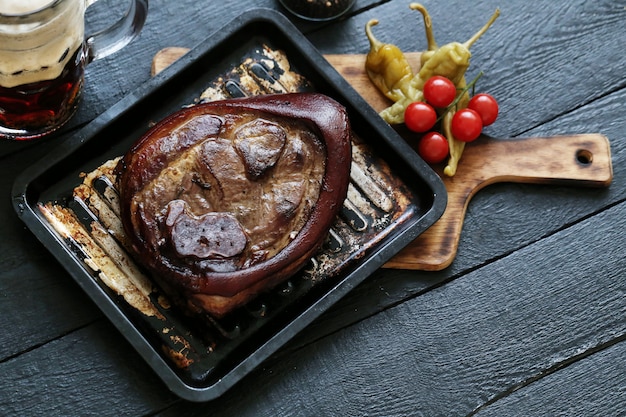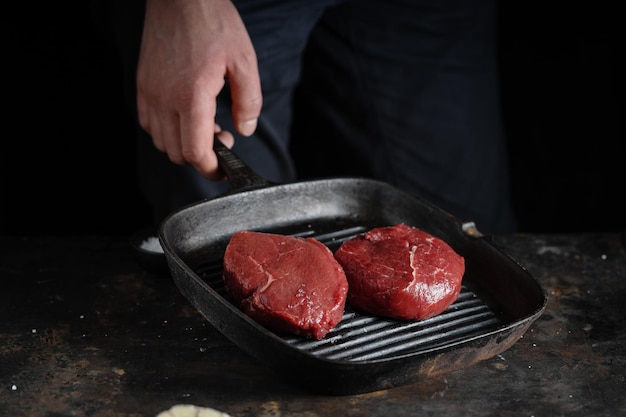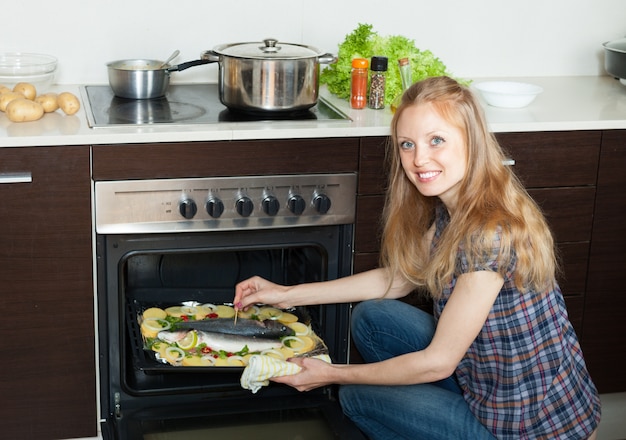Ah, the tenderloin. It’s a cut of meat that commands respect. But let’s be honest, it can be intimidating. You know that feeling: “Will I overcook it? Will it be dry?” Don’t worry, my friend. I’ve been there. But over time, I’ve cracked the code to perfect tenderloin, and trust me, it’s all about getting the oven cooking time just right. Let me share my insider tips for achieving mouthwatering, juicy results every single time.
(Part 1) Getting to Know Your Tenderloin

Before we even touch the oven, let’s delve a little deeper into this prized cut of meat. The tenderloin, officially known as the psoas major muscle, is a long, slender muscle that runs along a cow’s backbone. It’s a real culinary gem because it doesn’t get a lot of action. No heavy lifting for this muscle! That’s why it’s known for its incredible tenderness. It cooks up fast and evenly, making it a favourite for roasting and grilling.
The Size and Thickness Factor
But here’s the thing: tenderloins come in different shapes and sizes. You’ve got your petite little ones and then you have those behemoths. This is where we need to pay attention, because a slender, petite tenderloin will cook up quicker than a thick, hefty one. It’s all about knowing your meat, right?
Preparing for Success
Before you even think about the oven, let's set the stage for a successful tenderloin experience. I always start by trimming any excess fat, but I leave a thin layer behind - that’s where the flavour is at! Then, I get generous with the seasoning. Salt and pepper are non-negotiable, but I often add a touch of garlic powder or paprika for an extra kick. Remember, we want to enhance the natural flavours, not overpower them.
(Part 2) Oven Cooking: The Tenderloin's Best Friend

For me, oven cooking is the winning method for getting a perfect tenderloin every time. It’s consistent, reliable, and delivers those melt-in-your-mouth results. Here’s the breakdown:
Preheat It Like a Pro
Start by preheating your oven to 400°F (200°C). This ensures even heat distribution, which is vital for a tenderloin that cooks quickly and evenly. Imagine a symphony of heat, playing across your meat!
The roasting time Dance
Now, let’s talk roasting time. It’s a bit of a dance, and it depends on the size and thickness of your tenderloin. Here’s a general guide to get you started:
| Tenderloin Size (Weight) | Roast Time |
|---|---|
| 1-2 lbs (450-900 grams) | 15-20 minutes |
| 2-3 lbs (900-1.35 kgs) | 20-25 minutes |
| 3-4 lbs (1.35-1.8 kgs) | 25-30 minutes |
But remember, this is just a guide. You need to trust your gut (and a trusty meat thermometer!). We want the internal temperature to reach 145°F (63°C) for medium-rare, 160°F (71°C) for medium, and 170°F (77°C) for well-done. No guesswork here!
The Resting Ritual
Now, the grand finale: resting. Once your tenderloin is cooked, let it rest for 10-15 minutes before slicing. This allows those delicious juices to redistribute throughout the meat, resulting in a truly tender and flavourful experience. I usually cover it loosely with foil to keep it warm while it rests, a little bit of pampering for our star ingredient.
(Part 3) Beyond Basic: Tenderloin Twists and Turns

Tenderloin doesn’t have to be a simple roast. It's a blank canvas waiting for your culinary creativity. Here are a few ideas to spice things up:
Herb-Crusted Tenderloin: A Symphony of Flavour
Imagine a tenderloin enveloped in a fragrant herb crust. It’s like a sensory journey! Combine chopped herbs like rosemary, thyme, and parsley with olive oil and salt. Coat your tenderloin generously with this mixture, and then roast as usual. The herbs will infuse the meat with their beautiful aroma and flavour, adding a touch of magic.
Garlic-Butter Tenderloin: A Classic with a Twist
This is a classic for a reason, my friend. It’s simple, yet utterly irresistible. Simply mix softened butter with minced garlic and herbs, and then spread it all over the tenderloin before roasting. This creates a luscious, flavourful crust that melts in your mouth. It’s a touch of decadence that elevates the experience.
Smoked Paprika Tenderloin: A Smoky Delight
If you’re a fan of smoky flavours, this is your new best friend. Sprinkle smoked paprika generously over the tenderloin before roasting. It adds a depth of flavour that’s simply irresistible. It’s like a campfire in your kitchen, but without the mess!
(Part 4) Avoiding Dry Tenderloin: The Ultimate Guide
Let’s face it, nobody wants a dry tenderloin. It’s a culinary tragedy! But fear not, I’m here to share some tried-and-true tips to ensure that your tenderloin stays juicy and delicious.
Rule Number One: Don't Overcook!
This is the ultimate commandment of tenderloin cooking. And that’s where our friend, the meat thermometer, comes in handy. It’s your trusty sidekick, ensuring you don’t go overboard. Remember, tenderloin cooks quickly, so it’s easy to overcook if you’re not paying attention.
Seasoning with Restraint
Too much salt can dehydrate the tenderloin, so let’s be wise with our seasoning. A light touch is key! Remember, we want to enhance the flavours, not drown them out.
The Basting Ritual: A Moistening Magic
Basting the tenderloin with pan juices or broth during cooking is like giving it a little sip of moisture. Use a spoon or a basting brush to drizzle those delicious liquids over the meat every 10-15 minutes. It’s like a little spa treatment for your tenderloin, keeping it hydrated and happy.
(Part 5) Tenderloin Pairings: The Perfect Sidekicks
A perfectly cooked tenderloin deserves equally delicious companions. Here are a few of my favourite pairings that will elevate your dining experience:
Roasted Vegetables: A Symphony of Colors and Flavors
Roasted vegetables, like asparagus, Brussels sprouts, or carrots, provide a beautiful contrast to the tenderloin. I often toss them with olive oil, herbs, and salt before roasting alongside the tenderloin. It’s a harmonious combination of textures and flavours, a culinary masterpiece.
Creamy Potatoes: Comfort and Indulgence
Creamy mashed potatoes, gratin dauphinois, or roasted potatoes are all fantastic companions for tenderloin. They add a comforting element to the meal, a warm embrace of flavour.
Sauces: A Touch of Magic
A simple sauce can really elevate a tenderloin. I often make a pan sauce by deglazing the roasting pan with wine or broth and adding butter and herbs. It’s a touch of magic, using the natural juices from the meat to create a flavourful symphony. Alternatively, a creamy mushroom sauce or a red wine sauce is also delicious.
(Part 6) My Personal Tenderloin Journey: From Disasters to Triumph
cooking tenderloin has become a personal journey for me, a quest for culinary perfection. I remember my first attempt, a disastrously dry piece of meat that left me feeling defeated. But I didn’t give up. I learned from my mistakes, researched different methods, and experimented with various techniques. Through trial and error, I discovered the key to perfectly juicy and flavourful tenderloin.
The most memorable moment was when I finally mastered the art of roasting a tenderloin. I invited friends over for a dinner party, and served them the perfectly cooked tenderloin with a creamy mushroom sauce and roasted vegetables. The compliments were pouring in, and I felt a wave of satisfaction that came from knowing I had achieved something truly delicious. It was a culinary triumph, a testament to my perseverance and passion.
(Part 7) Beyond the Basics: Tenderloin for the Connoisseur
While oven cooking is a great way to cook tenderloin, there are other techniques you can explore, especially if you’re looking for a more sophisticated approach.
sous vide cooking: Precision and Control
Sous vide cooking is all about precision and control. It involves sealing the tenderloin in a vacuum bag and cooking it in a water bath at a precise temperature. This method guarantees even cooking and prevents overcooking, resulting in a perfectly juicy and tender tenderloin every time. It’s like a spa treatment for your meat, ensuring it’s pampered and cooked to perfection.
reverse searing: A Game Changer
Reverse searing is a game changer for tenderloin. This technique involves cooking the tenderloin at a low temperature for a longer time, followed by a quick sear on the stovetop or under a broiler. It’s a brilliant way to develop a delicious crust while keeping the tenderloin moist and flavorful. It’s a beautiful combination of science and art.
The Roasting Rack: A Secret Weapon
For even cooking, I highly recommend using a roasting rack. It allows the hot air to circulate around the tenderloin, ensuring that it cooks evenly on all sides. It’s a simple trick, but it makes a world of difference.
(Part 8) Tenderloin FAQs: Your Questions Answered
I know you have questions. We all do! Let’s address some of the most common queries about tenderloin cooking.
Q1: What happens if I overcook the tenderloin?
Overcooked tenderloin will be dry and tough. The muscle fibers will shrink and become tough, making it difficult to chew. It’s a culinary tragedy! The best way to avoid overcooking is to use a meat thermometer and check the internal temperature frequently. Remember, it's better to be safe than sorry!
Q2: Can I cook tenderloin from frozen?
It’s not recommended to cook tenderloin from frozen. It will take longer to cook and may not cook evenly. It’s best to thaw the tenderloin in the refrigerator overnight before cooking. Give it time to defrost properly, so it cooks up perfectly.
Q3: Can I cook tenderloin on the stovetop?
Yes, you can cook tenderloin on the stovetop using a cast iron pan or a skillet. However, it’s crucial to cook it over medium heat to avoid overcooking. Remember to sear the tenderloin on all sides to develop a nice crust. It’s a technique that requires a little more attention, but it can be a delicious way to prepare your tenderloin.
Q4: How do I know when the tenderloin is done?
The most reliable way to determine doneness is by using a meat thermometer. Insert the thermometer into the thickest part of the tenderloin, making sure it doesn’t touch any bone. For medium-rare, the internal temperature should reach 145°F (63°C), for medium, 160°F (71°C), and for well-done, 170°F (77°C). It’s a simple test that will guarantee a perfectly cooked tenderloin.
Q5: What are some good side dishes to serve with tenderloin?
Roasted vegetables, creamy potatoes, and sauces are all delicious accompaniments for tenderloin. Some specific ideas include asparagus, Brussels sprouts, carrots, mashed potatoes, gratin dauphinois, pan sauce, creamy mushroom sauce, and red wine sauce. Get creative and choose your favourites!
Remember, cooking a tenderloin is a journey. Don’t be afraid to experiment, try new techniques, and have fun. Embrace the process and enjoy the delicious results!
Everyone is watching

Corn on the Cob: The Ultimate Guide to Perfectly Cooked Ears
Healthy MealsAh, corn on the cob. Just the name evokes images of sunny days, barbecues, and that sweet, juicy flavour that ...

Scallops: The Ultimate Guide to Perfect Cooking
Healthy MealsAh, scallops. Those delicate, sweet, and utterly delicious morsels of the sea. They hold a special place in my...

Spaghetti Squash: The Ultimate Guide to Cooking and Serving
Healthy MealsRemember that time you saw spaghetti squash at the supermarket, looking all bumpy and strange, and thought, "W...

Salmon Cooking Times: Perfect Guide for Every Recipe
Healthy MealsLet me tell you, cooking salmon is an art form. It's all about getting that perfect balance: juicy and tender,...

Ham Cooking Time: How Long to Bake, Smoke, or Boil a Delicious Ham
Healthy MealsAh, ham. It's a classic, isn't it? A real crowd-pleaser, especially around holidays. And when done right, it'...
